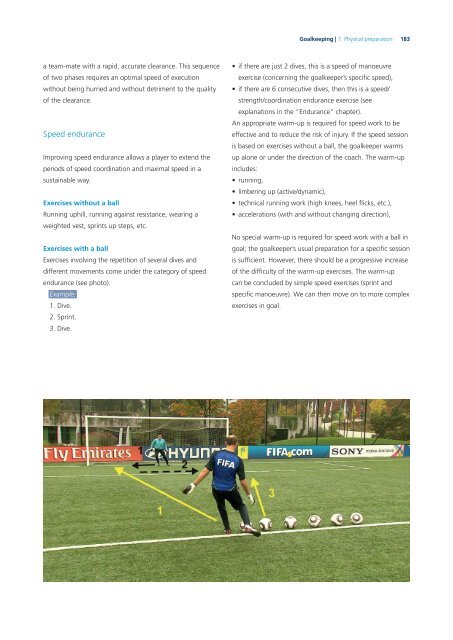Goalkeeping-bok
Goalkeeping-bok
Goalkeeping-bok
Create successful ePaper yourself
Turn your PDF publications into a flip-book with our unique Google optimized e-Paper software.
a team-mate with a rapid, accurate clearance. This sequence<br />
of two phases requires an optimal speed of execution<br />
without being hurried and without detriment to the quality<br />
of the clearance.<br />
Speed endurance<br />
Improving speed endurance allows a player to extend the<br />
periods of speed coordination and maximal speed in a<br />
sustainable way.<br />
Exercises without a ball<br />
Running uphill, running against resistance, wearing a<br />
weighted vest, sprints up steps, etc.<br />
Exercises with a ball<br />
Exercises involving the repetition of several dives and<br />
different movements come under the category of speed<br />
endurance (see photo).<br />
Example:<br />
1. Dive.<br />
2. Sprint.<br />
3. Dive.<br />
<strong>Goalkeeping</strong> | 7. Physical preparation<br />
183<br />
• if there are just 2 dives, this is a speed of manoeuvre<br />
exercise (concerning the goalkeeper’s specifi c speed),<br />
• if there are 6 consecutive dives, then this is a speed/<br />
strength/coordination endurance exercise (see<br />
explanations in the “Endurance” chapter).<br />
An appropriate warm-up is required for speed work to be<br />
effective and to reduce the risk of injury. If the speed session<br />
is based on exercises without a ball, the goalkeeper warms<br />
up alone or under the direction of the coach. The warm-up<br />
includes:<br />
• running,<br />
• limbering up (active/dynamic),<br />
• technical running work (high knees, heel fl icks, etc.),<br />
• accelerations (with and without changing direction),<br />
No special warm-up is required for speed work with a ball in<br />
goal; the goalkeeper’s usual preparation for a specifi c session<br />
is suffi cient. However, there should be a progressive increase<br />
of the diffi culty of the warm-up exercises. The warm-up<br />
can be concluded by simple speed exercises (sprint and<br />
specifi c manoeuvre). We can then move on to more complex<br />
exercises in goal.


